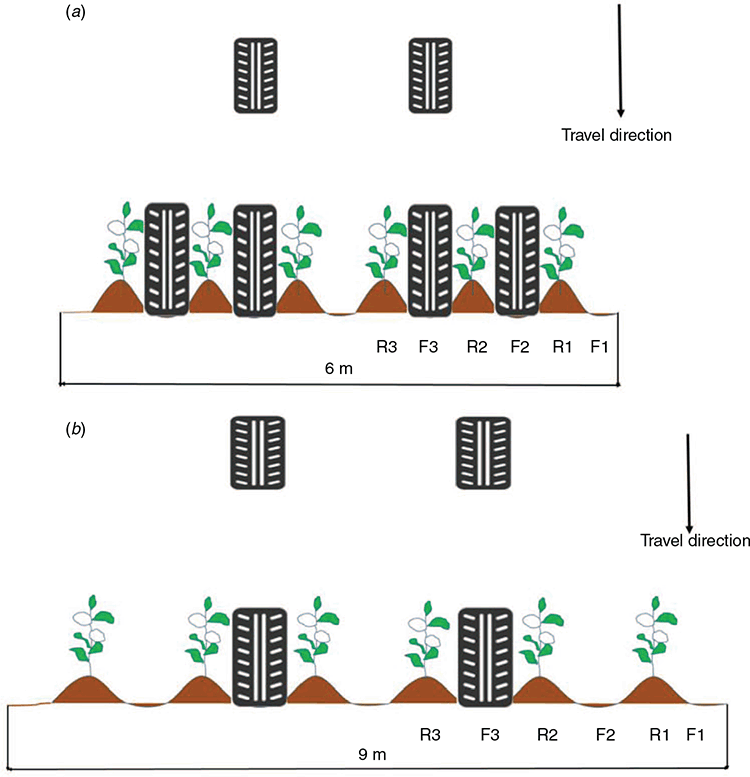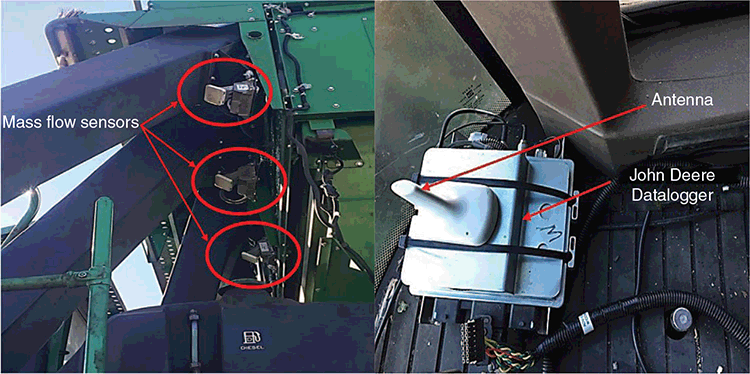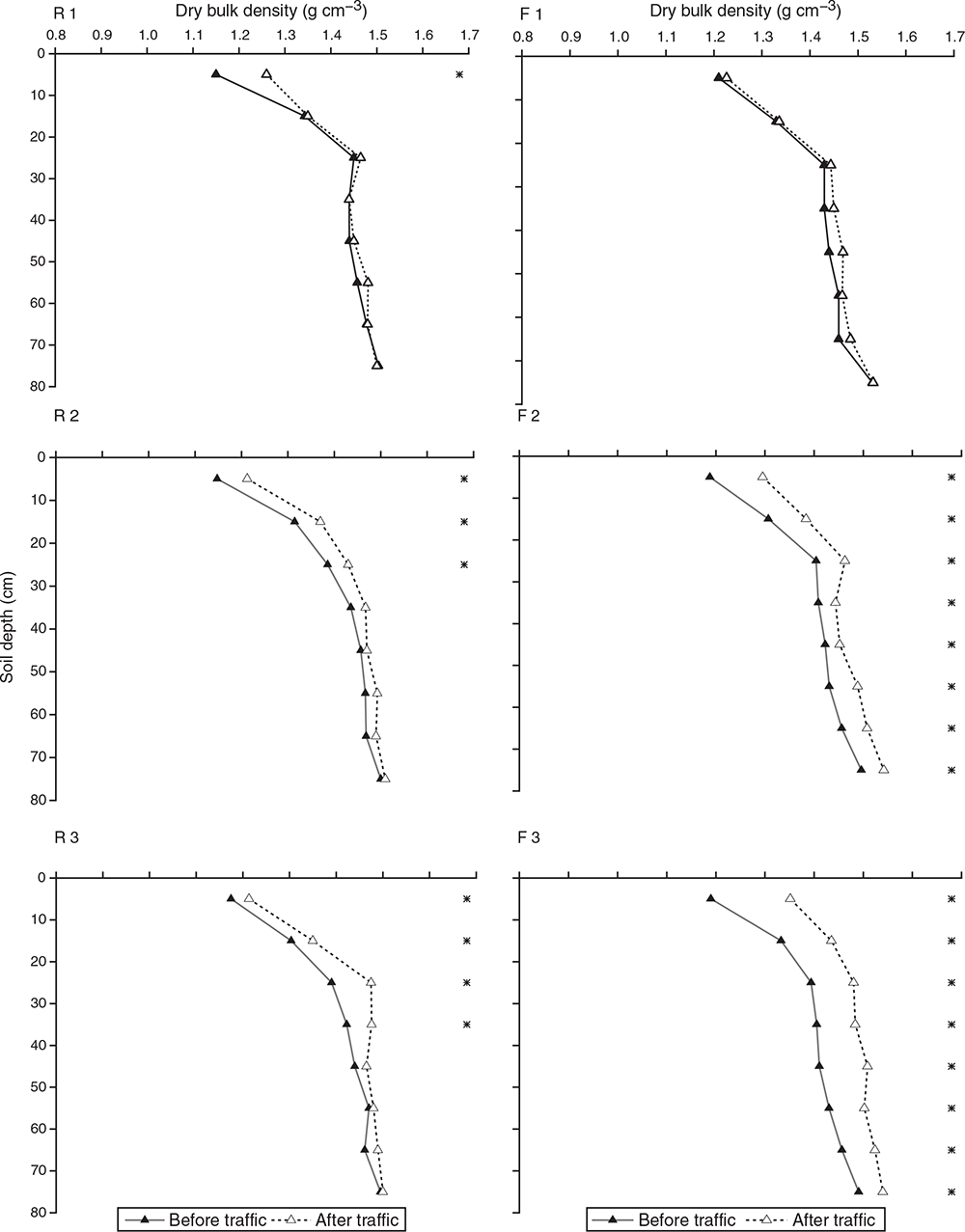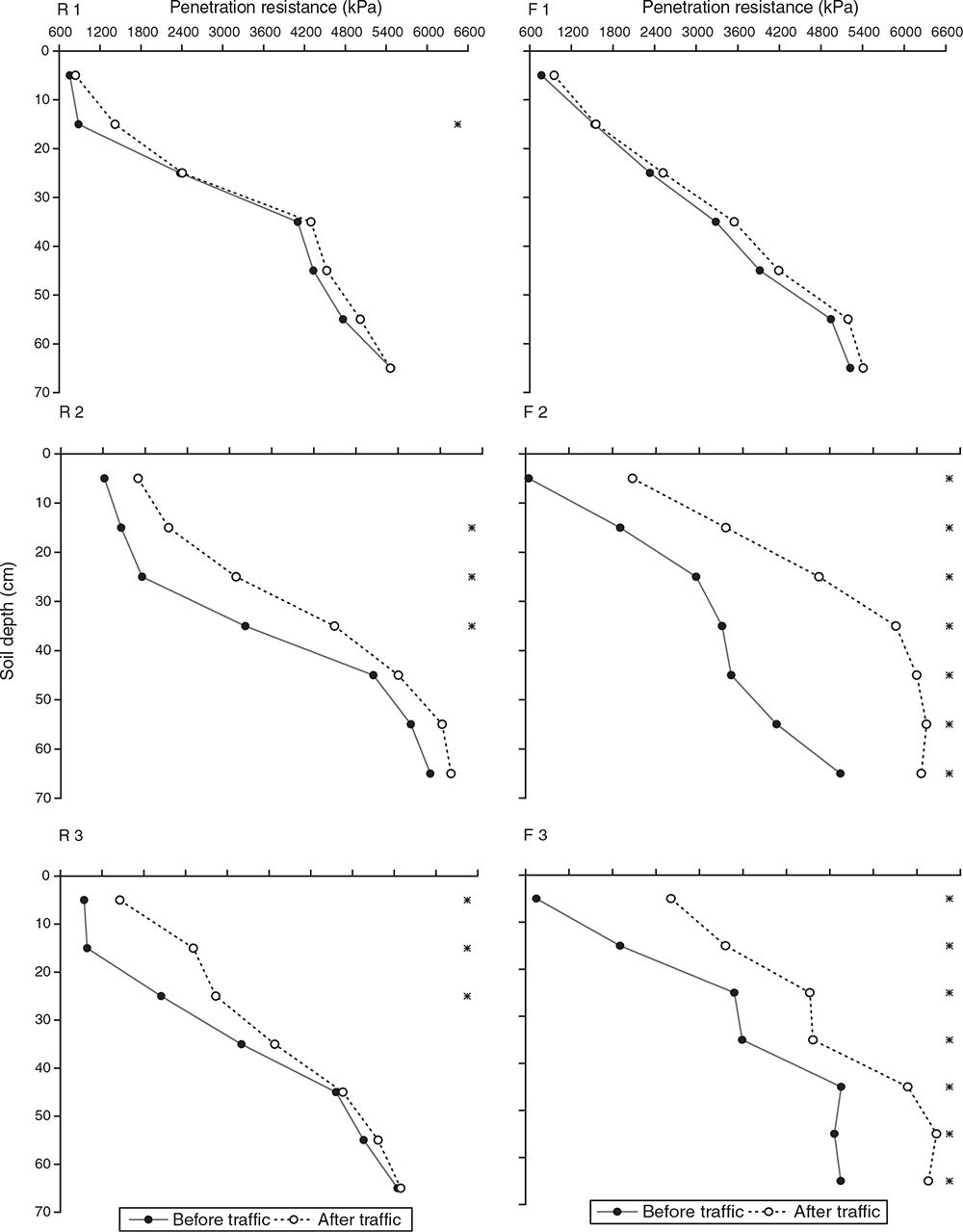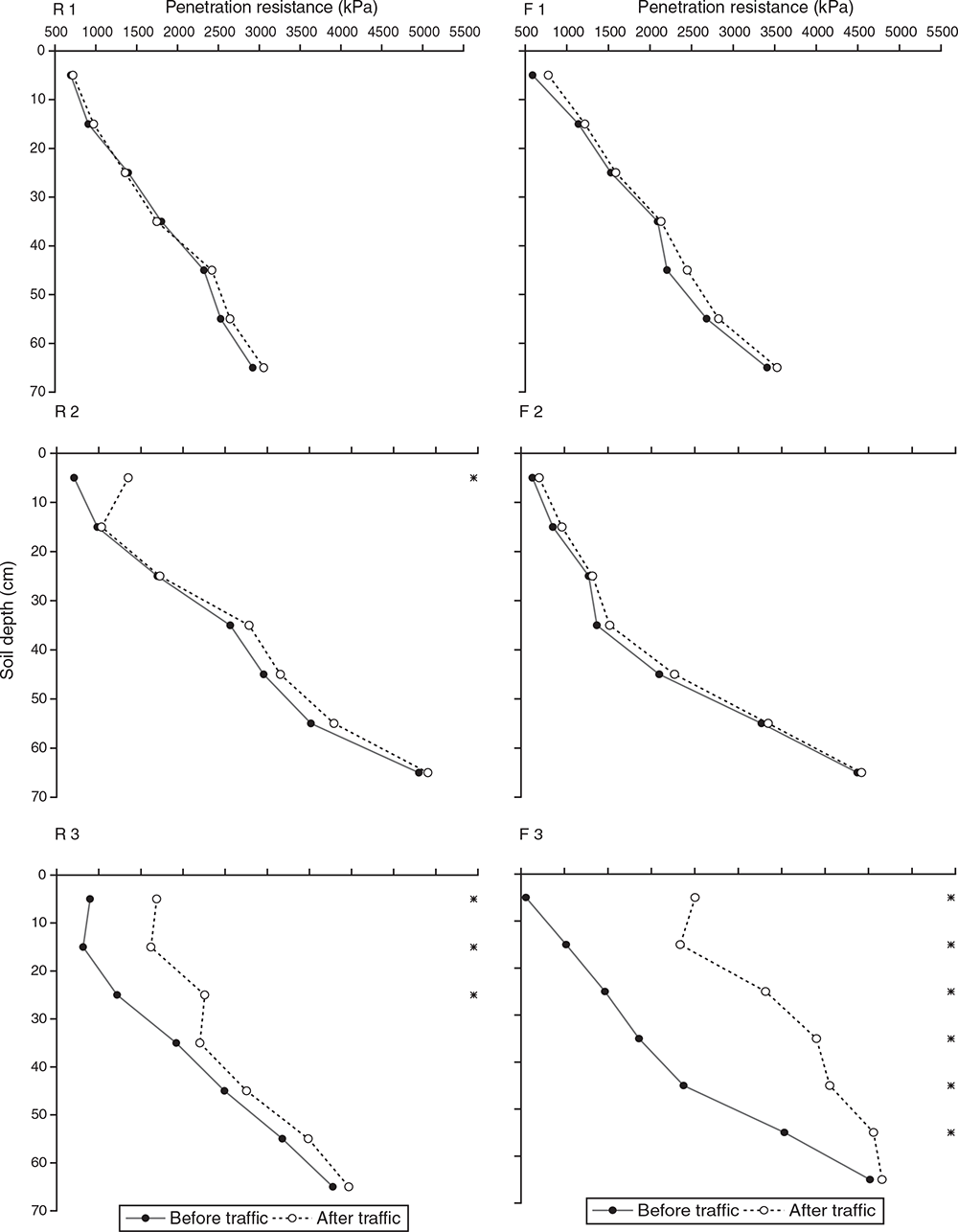Impact of cotton picker traffic on vertosol soil and yield in individual rows
Mohammed A. M. Al-Shatib A B C , John McL. Bennett A D , Guangnan Chen
A D , Guangnan Chen  A D and Troy A. Jensen A
A D and Troy A. Jensen A
A Faculty of Health, Engineering and Sciences, University of Southern Queensland, Toowoomba, Qld 4350, Australia.
B Ministry of Agriculture, Baghdad, Iraq.
C University of Baghdad, PO Box 17635, Jadiriya, Baghdad, Iraq.
D Corresponding authors. Email: Guangnan.Chen@usq.edu.au; John.Bennett@usq.edu.au
Crop and Pasture Science 72(7) 514-527 https://doi.org/10.1071/CP20360
Submitted: 20 September 2020 Accepted: 29 April 2021 Published: 29 July 2021
Journal Compilation © CSIRO 2021 Open Access CC BY
Abstract
This study investigated the impact of soil compaction owing to cotton picker traffic, and the impact of this compaction on cotton yield on a row-by-row basis across the field under both random traffic farming (RTF) and controlled traffic farming (CTF) systems. Measurements of soil water content, dry bulk density and soil penetration resistance were taken and compared with a depth of 80 cm both before and after traffic. It was found that the traffic of JD7760 round-bale cotton picker caused significant compaction in cotton rows and furrows located between, adjacent to, and in wheel tracks under both RTF and CTF systems, particularly for the top 30-cm depth. Because of the soil compaction, the yield was more significantly reduced (7~10% by the machine-pick method) in the rows between the dual-wheel than in those adjacent to the wheel track. Adopting CTF reduces the area of soil compaction and ensures the maintenance of soil characteristics of the cultivated portions of the farm, hence enhancing cotton yield.
Keywords: cotton picker, soil compaction, controlled traffic farming, yield.
Introduction
Cotton (Gossypium hirsutum L.) is an important industrial crop of considerable economic value in many countries. The major cotton producers in the world include China, the USA, India, Pakistan and Brazil. They together contribute ~75% of global production (Yadav et al. 2018). In recent years, Australia has become one of the leading cotton producers and the third-largest exporter, with the highest average yield per hectare in the world (Eskandari et al. 2017, 2018).
Cotton performs well on Vertosols, earning the worldwide title ‘Black Cotton Soil’ (Ahmad 1983; Oza and Gundaliya 2013). This reputation is due to cotton’s vertical root system, which is not significantly damaged by the cracking of the Vertosols (IUSS Working Group WRB 2015). Vertosols make up ~75% of the soils under cotton production in Australia (McKenzie et al. 2003). These soils have a unique morphology resulting from the swelling–shrinking of the clays on changes in moisture content (Potter and Chichester 1993; Patil et al. 2012). However, Vertosols are susceptible to compaction, especially under wet conditions (Chan et al. 2006). With just one pass of heavy machinery, significant compaction reaching deep into subsurface layers can occur (Bennett et al. 2019).
Soil compaction is also a major global challenge in mechanised crop production (Soane and Van Ouwerkerk 1994; Batey 2009; McPhee et al. 2018). This challenge is exacerbated when the machinery size and weight continue to increase in the quest to increase production and profitability (Hamza and Anderson 2005; Głab 2014). It has been suggested that one of the effective ways to prevent or minimise soil compaction in a highly mechanised farming system is the adoption of CTF that minimises the area affected by machinery traffic (Tullberg 2010).
The farming systems, in terms of machinery traffic, employed by cotton growers around the world can broadly be classified as either random traffic farming (RTF) or controlled traffic farming (CTF). RTF is the conventional system of traffic in which there are no permanent paths for machinery traffic (Gasso et al. 2013). This implies that over time, soil compaction owing to machinery traffic occurs haphazardly on the cultivated field. Trafficking under RTF typically covers 85% and above of the field whenever a crop is produced (Kroulík et al. 2009). This is compared with CTF where dedicated permanent lanes are used year-in and year-out, restricting machinery passage to specific uncultivated paths (Tullberg et al. 2007; Antille et al. 2016; Lu et al. 2016).
Around the world, farmers employ a variety of harvesters and pickers to harvest cotton. Australia and the USA are the two main countries in the world where all cotton harvesting is mechanised (Muthamilselvan et al. 2007). One of the most popular cotton pickers in these two countries is the John Deere 7760 cotton picker (JD7760). As present, this cotton picker is used in more than 80% of Australian cotton farms (Bennett et al. 2019). Its high adoption rate could be attributed to its improved operation safety, efficiency and operating costs relative to previous basket pickers (Bennett et al. 2015). Particularly, the new round-bale cotton picker has eliminated the need for module builders, boll buggies and tractors, and, thus, has significantly reduced the labour cost (Jason Daniel 2008).
However, with all these improvements, this cotton picker weighs ~32 t. This is about two times as heavy as its previous models (Braunack and Johnston 2014; Bennett et al. 2015), which leads to increased compaction in the wheel tracks, especially in the topsoil (Bartimote et al. 2017), and can spread to adjacent rows (Braunack and Johnston 2014). In an attempt to minimise compaction risk as a result of an increased axle weight, the front axle has been fitted with dual-wheels and larger tyres (520/85R42 R1R2; John Deere 2016). Nevertheless, traffic of the inner and outer front dual-wheels has been identified as a major cause of compaction to depths of up to 80 cm in Vertosols (Bennett et al. 2017).
A modified version of the JD7760 picker has also been adapted for harvesting under CTF (CTF7760). The modifications include an increase in the frontage width from 6 to 9 m and the replacement of the front dual-wheels with single 620/70R42 wheels (Antille et al. 2016). Bennett et al. (2017) reported that the main difference between the use of the JD7760 and CTF7760 is that ~66% and 50% of cotton furrows are subjected to harvester wheel traffic under RTF and CTF respectively. However, harvest traffic from the JD7760 picker, regardless of RTF or CTF, still results in soil degradation in the wheel track at different soil depths (Bennett et al. 2016).
Harvester traffic is a serious issue, particularly when soils are subjected to trafficking without annual ripping operations (Hamza and Anderson 2005). Given that Vertosols readily experience significant compaction even as a result of a single pass, trafficking with the heavier JD7760 and CTF7760 worsens the compaction (Bennett et al. 2017). Daniells (1989) reported that the yield of cotton grown in Vertosol could be reduced by more than 33% when the soil is subjected to harvest traffic, particularly under wet conditions. Coelho et al. (2000) also observed a significant decline in cotton yield as a result of compaction when dry bulk density increased to 1.60–1.70 g/cm3. Also, compaction resulting from the random traffic of a harvester was found to be the main reason for the significant decrease (24%) in cotton yield reported by Braunack (2013).
A substantial amount of research (Braunack 2013; Braunack and Johnston 2014; Antille et al. 2016; Bartimote et al. 2017; Bennett et al. 2017, 2019; Roberton and Bennett 2017) has studied the effect of compaction due to JD7760 traffic on soil structure and cotton yield. However, these results are usually represented as the overall results across the field. There appears to be a lack of data and studies in the row-by-row impact of the JD7760 cotton picker traffic on soil compaction and cotton yield.
Because of the wheel arrangement of the JD7760 and CTF7760 cotton pickers relative to cotton rows, the degree of compaction caused by wheel traffic will not be uniform for all rows. Braunack and Johnston (2014) found that compaction caused by harvester wheel traffic could spread to adjacent rows. To understand the variation in cotton yield across the field and within a picker pass, investigation of row-by-row variations in compaction, particularly in Vertisols, was necessary.
Therefore, this study aimed to investigate soil compaction owing to the JD7760 cotton picker and its influence on individual cotton rows under RTF and CTF systems. Understanding the row-by-row variation will enable cotton farmers to be more specific in their compaction remediation treatments, so as to achieve both cost and time savings by adopting better strategic management and the development of aids for better production decision-making under different levels of soil compaction.
Materials and methods
Site description
Two cotton fields were measured to investigate the impact of JD7760 cotton picker traffic on soil compaction and potential yield row-by-row in the 2016/2017. Both sites (Undabri and Yambacully) were located near Goondiwindi, Queensland, Australia (Table 1). These fields were chosen because of their range of traffic histories that could be assessed. The fields were also selected to be representative of Vertosols as much as reasonably possible. The Grey Vertosol is the predominant soil type in these districts; however, because these are alluvial soils, soil sequences are common. No deep-soil tillage occurred before planting at both sites. Cotton (Gossypium hirsutum L. S71BR) was planted in this region because of the suitability of the soils, access to water, and a suitable climate. The industry-standard farming system is random traffic farming (1.0-m row spacing), which has been in operation at Undabri since 2012 and is harvested by the JD7760 standard configuration, while CTF with 1.5-m row spacing was adopted at Yambacully in 2015 and the harvest was picked with the CTF7760 modified harvester.

|
Experiment design
The experiments were conducted to examine the influence of soil compaction at the level of individual rows and furrows. Two blocks were chosen in each site. Each block had six sampling transects. The transects were randomly assigned in each block to reduce the chance of biased results. The blocks were designed so that they captured the full frontage of the JD7760 (six picking rows). The length of each block was 324 m, and the width was 6 m for RTF and 9 m for CTF (Fig. 1). The transect dimensions were 1.5 m in length and 6 m in width to correspond with the JD7760 standard frontage, whereas the width was 9 m to match the CTF traffic system (Fig. 1). Both harvesters had the same front and rear wheel loads (10 860 kg at front and 8250 kg at rear when the harvesters were empty), but they had different wheel configurations (dual-wheel and single-wheel) to match random and controlled traffic systems. Soil water content (Swc), dry bulk density (Pb) and soil penetration resistance (SPR) were measured before and after harvester traffic to a depth of 80 cm, to assess the degree of soil compaction. These parameters were measured in cotton rows numbered Row 1, Row 2 and Row 3. At the RTF site, Row 2 was located between the front dual-wheels of the JD7760, and Row 1 and Row 3 were located on the outer and inner sides of the wheels respectively (Fig. 2a). At the CTF site, CTF7760 wheel traffic was between Row 2 and Row 3. Row 1 was separated from the wheel by Row 2 and a furrow because of harvester modification (Fig. 2b).
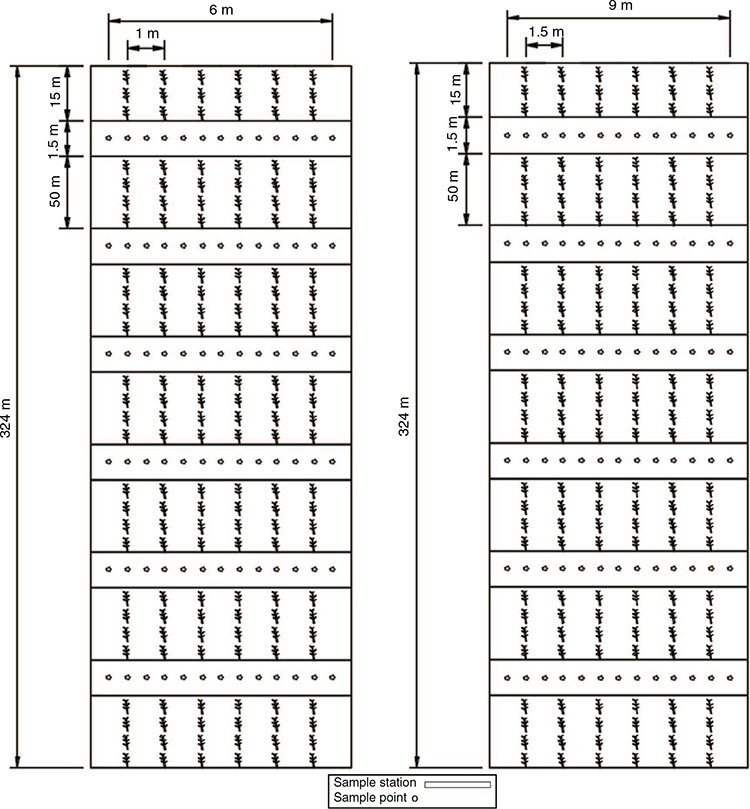
|
Soil sampling
A portable petrol post driver (Christie’s Engineering CHPD 78 Post Driver, 4 strokes), volumetric cylinder (thin-walled metal tube 1500 mm in length and 52.5 mm in diameter), and foot lever were used to collect soil samples for both sites. Samples were collected from the position of each cotton row and furrow of each transect to a soil depth of 80 cm before and after harvester traffic. The incidence of sampling was based on the procedure outlined in McKenzie et al. (2002). Soil sample collection was performed by driving the sampling cylinder vertically into the soil to the desired depth, by using the jackhammer. The cylinder was carefully removed by the extraction lever. Because the core-sampling procedure used a hammering action to push the cylinder to the desired depth, the extracted core length was measured and compared against the hole depth to ensure that compaction had not occurred during sampling. It was found that this approach did not cause compaction of samples (McKenzie et al. 2002; Bennett et al. 2017). Each tube provided an 800-mm sample and could be separated into 100-mm subsamples. Overall, the field trials provided a total of 624 tubes, which, divided into 10-cm subsamples, generated a total of 4992 samples (Table 2).

|
Soil water content and dry bulk-density measurements
The laboratory measurements were based on the method outlined in International Organisation for Standardisation (11272, ISO 2017). Soil cores were directly weighed after completing field experiments, and then placed in the oven for at least 72 h at 105°C, so as to determine the dry weight of each sample. Soil water content (Swc) was calculated on the basis of gravimetric, and then converted into volumetric, soil water content and is shown as a percentage. The dry bulk density (Pb) of the soil was calculated by oven-dry weight of soil per unit of volume, reported in g cm–3.
Soil penetration resistance
A static cone penetrometer CP40II (Rimik) and load cell rated at 100 kg were used to measure soil penetration resistance. A small cone size (130 mm2, 12.83-mm diameter) with shaft (9.53-mm diameter) was selected because it suits hard soils (ASAE 1986). This cone penetrometer was able to measure soil strength up to 5.6 MPa and can reach soil depth of 750 mm, with intervals of 10, 15, 20 and 25 mm (Rimik 2017). The penetrometer was mounted to the constant drive device to ensure that the cone was driven into the soil at a constant penetration rate (42.5 mm/s; Rimik 2017). The crop and cotton hills were removed from soil sampling stations. In both farms, SPR measurements were taken when the soil cores were collected (Ayers and Perumpral 1982). Resistance measurement was recorded at each 10-mm depth (up to 700 mm), with an insertion spacing of 250 mm across picker frontage (Braunack and Johnston 2014). These processes resulted in 660 insertions for both Undabri and Yambacully.
Cotton yield
The cotton crops were planted with row spacing of 1.0 m at Undabri and 1.5 m at Yambacully. Two cotton pickers (JD7760) were employed to harvest the study areas. A standard picker (6-m frontage with front dual-wheels) was used (Fig. 3a) to harvest at Undabri. The CTF7760 modified harvester was employed (Fig. 3b) at Yambacully, enabling it to pick 6 rows (1.5-m row spacing) over 9 m. This modification also involved removing the dual-wheels and replacing them with a single tyre 620/70R42. The 7760 John Deere Harvest Identification (Harvest Doc and CAN-BUS) and John Deere-Datalogger were also utilised in this study to extract yield data from individual rows. Six flow-mass sensors were installed on the ducts of the harvester to measure the amount of yield passing through the ducts during harvest operation (Fig. 4). The John Deere-Datalogger transferred the data so that it was available in the MyJohnDeere portal and was processed and set up as an excel spreadsheet. The hand-picked yield was also used to calibrate the machine-picked yield, because the sensors of machine-picked yield might have some calibration limitations. Furthermore, the measurement of yield of each row was accounted as a 1.5 m2 per metre for CTF and a 1.0 m2 per metre for RTF, which were, thereafter, converted into bale per hectare (1 bale = 227 kg lint yield).

|
Statistical analysis
ANOVA was performed in this study. The data were analysed statistically by utilising the software package (Statistical Package for Social Scientists) IBM SPSS version 23.0 (IBM 2016). Significant difference between data were tested using the l.s.d. test.
Results
For the soil characteristic results presented in the figures of this section below, the symbol (*) represents a significant difference at P = 0.05 level between before and after harvester traffic. The letters R1, R2 and R3 in the figures represent Row 1, Row 2 and Row 3 respectively, and F1, F2 and F3 represent Furrow 1, Furrow 2 and Furrow 3 respectively.
Soil water content and dry density
Figure 5 shows the results of Swc before and after harvester traffic in Row 1 for Undabri. When comparing before and after traffic, there was not a significant difference in Swc at P = 0.05 level for all cotton rows and furrows of both sites throughout the profile depth. This was because the soil-sample collection occurred immediately before and after traffic and within a 1–2 day duration.
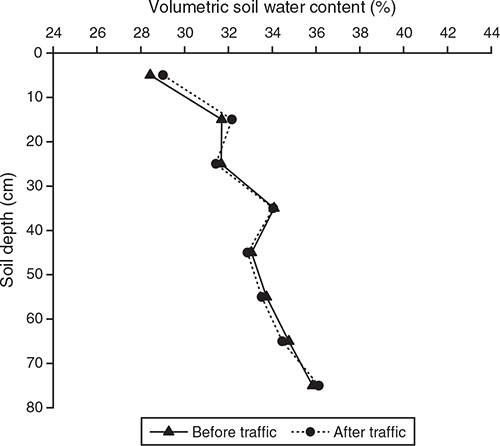
|
Row 1 at Undabri showed a lower Pb before traffic than after traffic, by ~10% in the topsoil, whereas it increased in Row 2 from 1.28 to 1.34 g/cm3 in the surface soil when compared with before traffic (Fig. 6). A significant increase in Pb was observed in Row 3 after harvest (6%) in the depth of 0–20 cm. The comparison between before and after traffic of the JD7760 standard configuration did not show significant differences in Pb in Furrow 1 throughout the 0–80-cm soil depth. Traffic from the JD7760 caused significant compaction, resulting in increased Pb in Furrow 2 and Furrow 3 for the 0–80-cm depth.
ANOVA analysis of field data showed that traffic from the CTF7760-modified configuration caused no significant difference in Pb in Row 1 throughout the 0–80-cm soil depth. The results also showed that Pb increased significantly in Row 2 and Row 3, from 1.18 to 1.24 g/cm3 and from 1.29 to 1.35 g/cm3 in the 0–10-cm and 0–30-cm depths respectively (Fig. 7). Furrow 1 and Furrow 2 did not show a significant difference in Pb throughout the 0–80-cm depth after traffic. Furthermore, one pass from the CTF7760 caused significant compaction in Furrow 3, which resulted in an increase of Pb from 1.42 to 1.52 g/cm3 for the 0–80-cm depth.
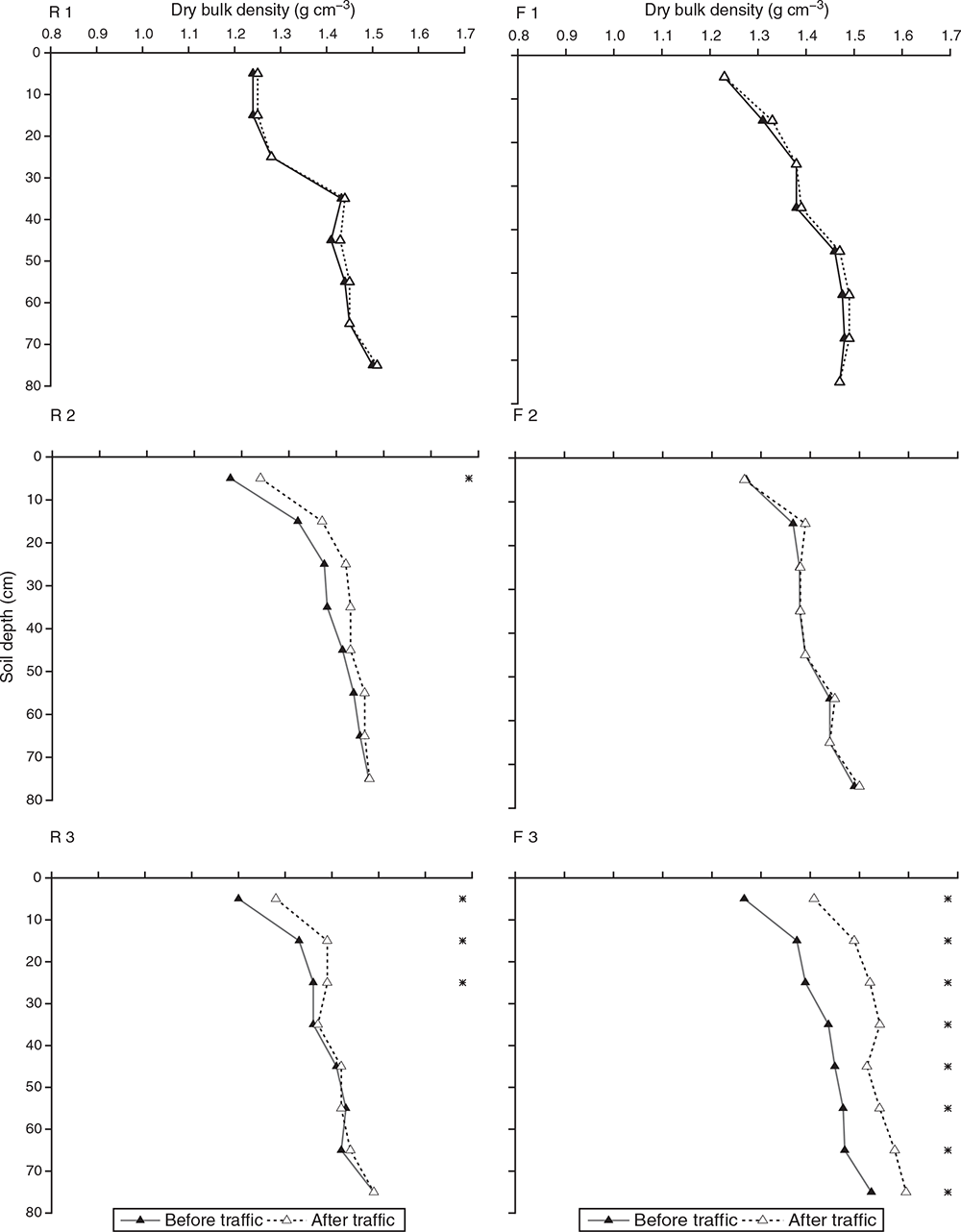
|
Soil penetration resistance
Overall, soil penetration resistance (SPR) showed a similar trend to Pb across the study fields. The results showed that SPR significantly increased in Row 1, Row 2 and Row 3 at Undabri after harvester traffic, by 61%, 50% and 71% for the 10–20-cm, 10–40-cm and 0–30-cm depths (Fig. 8). Furrow 1 under RTF system did not show any significant difference in the SPR for the 0–70-cm soil depth after traffic. Furthermore, one pass from the JD7760 standard caused significant compaction that led to an increased SPR in Furrow 2 and Furrow 3, by approximately by 60% and 30% at the depth of 0–70 cm.
There was no change in SPR in Row 1 after one pass of the CTF7760 at Yambacully throughout the depth profile, whereas the values of Row 2 and Row 3 showed a significant increase by 90% for the 0–10-cm and 0–30-cm depths when comparing before and after harvester traffic (Fig. 9). Examining the before and after traffic under CTF system demonstrated no differences in the SPR in either Furrow 1 or Furrow 2 throughout the profile depth, whereas a significant compaction was found in Furrow 3 after harvest traffic, which led to an increased SPR to ~3444 kPa at the depth of 60 cm.
Cotton yield
The CAN-BUS data showed that the yield in cotton rows varied between 6.63 and 7.14 bales/ha at Undabri. The yield was significantly higher in Row 1 (7.14 bales/ha) than in Row 2 (6.45 bales/ha) and Row 3 (6.63 bales/ha) respectively (Fig. 10). There was much less difference in yield between Row 2 and Row 3. The hand-picked method showed a higher yield in Row 1 (9.37 bales/ha) than in Row 2 (8.21 bales/ha) and Row 3 (8.65 bales/ha; Fig. 10). The comparison between Row 2 and Row 3 again did not show any difference.
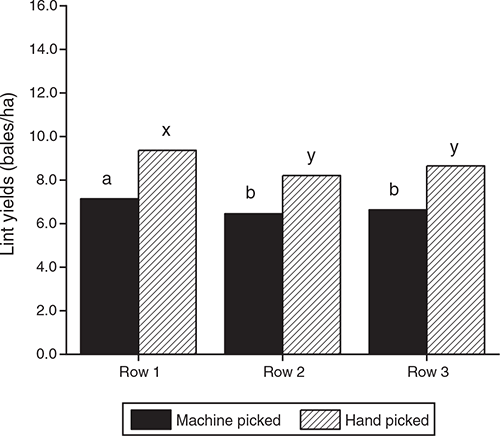
|
The Yambacully site produced a higher yield in Row 1 (9.60 bales/ha) than in Row 2 (8.91 bales/ha) and Row 3 (8.55 bales/ha) for machine-picked harvest. Furthermore, hand-picked harvest also showed that Row 1 (12.70 bales/ha) achieved a higher yield than did Row 2 (10.46 bales/ha) and Row 3 (10.14 bales/ha) respectively (Fig. 11). No difference in the yield was observed between Row 2 and Row 3 for the two methods.
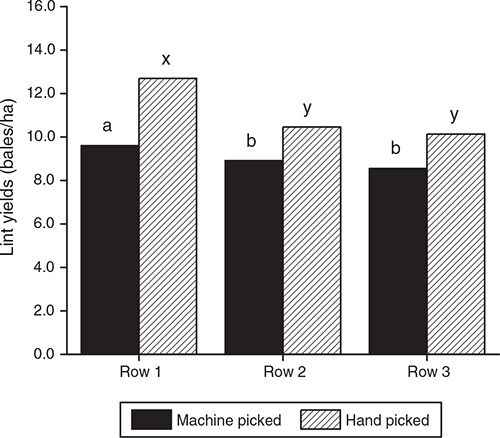
|
Discussions
Impact of the JD7760 traffic on moisture content, dry density and soil strength
The Vertosol soil type has weaknesses in terms of its structural stabilisation of the water and slow infiltration rates that are related to heterogeneity and clay mineralogy (Ghosh et al. 2010). As expected, there was no significant effect of harvester traffic in the soil water content across all treatments throughout the profile depth for both sites because sampling occurred directly before and after traffic (Bennett et al. 2017).
Antille et al. (2016) and Bennett et al. (2017) found that, with both RTF and CTF, traffic from the JD7760 cotton picker could produce significant compaction. The key differences between those systems were that underneath the CTF harvester, ~50% of furrows were subject to harvester traffic, whereas 66% of furrows were subject to traffic under the JD7760 standard configuration (Bennett et al. 2017). Comparative analysis for the Undabri site in terms of affecting the SPR and Pb demonstrated that one single pass of the standard JD7760 resulted in increasing the values in the topsoil in Row 1. In contrast, Row 1 at Yambacully did not show a change either in SPR or dry bulk density throughout the depth profile. From Fig. 2, it can be noted that Row 1 at Undabri was subjected to the effect of the outer dual-wheel traffic, which resulted in an increased SPR and a reduced porosity underneath the wheel track, and spread to reach adjacent cotton rows, whereas the space between Row 1 and the traffic lane under the CTF provided a protection to the soil’s structural arrangement (Braunack et al. 2012; Bennett et al. 2017).
An increase in the SPR and Pb was observed in Row 2 and Row 3 in the surface soil at Undabri and Yambacully, when compared with Row 1. This suggests that Row 2 under RTF was compressed by the dual-wheel after harvest, which had a sufficient wheel load to change the soil structural arrangement, whereas Row 3 was influenced by the combined effect of the inner dual-wheel and rear tyre traffic. This made significant compaction beneath the wheel track and resulted in an increased SPR and expanded to Row 3. Furthermore, the permanent traffic lane under the CTF system was mainly limited between Row 2 and Row 3, therefore resulting in an increased SPR and Pb (McGarry 1996; Braunack et al. 2012; Antille et al. 2016).
There was no influence of the JD7760 standard traffic in Furrow1 at Undabri throughout the depth profile compared with that before traffic, indicating that Furrow1 was not subject to wheel traffic during the harvest period. The comparison between before and after traffic did not also show an impact of the CTF7760-modified configuration in both Furrow 1 and Furrow 2 throughout the entire profile. This suggests that CTF played a significant role in avoiding compaction occurrence or minimising soil structure damage through restricting traffic lanes (Tullberg 2010; Antille et al. 2016). Traffic from the JD7760 standard produced a significant compaction in both Furrow 2 and Furrow 3 at Undabri, down up of 60-cm depth. Following the same trend, significant compaction was observed in Furrow 3 after one single pass of the CTF7760 harvester, compared with before traffic. These indicated that wheeled traffic over the furrows induced significant compaction irrespective of controlled or random traffic approaches (Hamza and Anderson 2005; Bartimote et al. 2017).
Effect of compaction on individual row yield
The crop yield can provide a good indication of the compaction state. More than one-third of the actual yield may be lost when soil structure is damaged by compaction (Daniells 1989). The standard and CTF JD7760 harvesters induce comparable compaction; however, the standard system affects 17% more land because of the dual-wheel system (Bennett et al. 2017). Adoption of CTF can reduce the cropped regions affected by traffic by more than 50% (Galambosova et al. 2017). In fact, one of the key motivations for the adoption of CTF is that it minimises the area of soil compaction and ensures the maintenance of soil properties of the cultivated portions of the farm, thereby enhancing crop yield and reducing energy requirements (Kingwell and Fuchsbichler 2011; McPhee et al. 2013; Chamen et al. 2015; ACTFA 2017). In this study, Row 1 at Undabri achieved a higher yield (7.14 bales/ha) than did Row 2 (6.45 bales/ha) and Row 3 (6.63 bales/ha), whereas no significant difference in the yield was observed between Row 2 and Row 3. It can be seen that in the random traffic system, the surface soil in Row 2 was most influenced by harvester traffic. This resulted in significantly changed soil characteristics owing to the effect of the inner and outer dual-wheel harvester traffic. This prevented roots from growing and led to a reduction in water infiltration and nutrient uptake, hence producing the lowest yield when compared with Row 1 and Row 3.
Under CTF, dedicated permanent lanes are used year-in and year-out, restricting machinery passage to specific uncultivated paths (Tullberg et al. 2007; Antille et al. 2016). CTF with a 1.5-m row spacing is currently used by the Australian cotton industry to avoid the risk of compaction and to improve cotton production (Tullberg et al. 2007; Tullberg 2010; Antille et al. 2016; Bennett et al. 2019). Adopting 1.5-m row spacing under CTF may restrict soil compaction to only 15–20% of the total area (Antille et al. 2016; Bartimote et al. 2017; Bennett et al. 2019). In addition, 1.5-m row spacing might achieve higher cotton yields by 30% after several years of adoption (Quigley et al. 2015; Bartimote et al. 2017). In this study, Row 1 at Yambacully showed a higher yield (9.60 bales/ha) than did Row 2 (8.91 bales/ha) and Row 3 (8.99 bales/ha), whereas there were no significant differences in the yield between Row 2 and Row 3. This was because that the space between Row 1 and the traffic lane provided a good soil structural arrangement. In contrast, the permanent traffic lanes were mainly between Row 2 and Row 3, which have directly affected crop performance and resulted in a lower yield than for Row 1 (Braunack et al. 2012; McPhee et al. 2015; Bennett et al. 2017). It seemed that cotton rows between the dual-wheels were more affected by compaction than were those neighbouring the wheel track, thus showing the lowest cotton yield (Fig. 12).
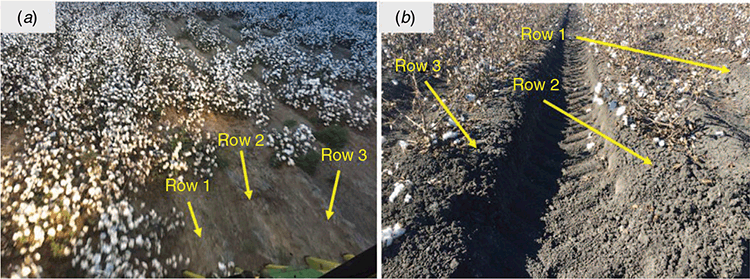
|
Conclusions
Row-by-row Vertosol soil compaction as a result of JD7760 cotton picker traffic and its impact on cotton yield under different row configurations was investigated in this study. It was found that wheel traffic resulted in changing soil properties in the different cotton rows that were between, neighbouring, and underneath the wheel track in the surface and subsurface layers, at both sites. At Yambacully, Row 1 was largely not influenced by harvester traffic and showed the lowest SPR and Pb throughout the depth profile. Row 2 and Row 3 were influenced by harvester traffic at both sites in the top 30-cm depth. Row 2 was the most sensitive to the effect of dual-wheel traffic, which resulted in a higher SPR and density in the surface soil. Wheeled furrows at both sites were sensitive to harvester traffic, which showed a significant compaction in the 0–80-cm depth compared with that before traffic. Row 1 achieved the highest yield at Undabri and Yambacully when compared with other row treatments. Row 2 at the Undabri site produced the lowest yield when compared with Row 1 and Row 3. Overall, traffic under CTF conditions provides a good soil structure that can positively reflect on the individual cotton yield. These findings have important implications for farmers intending to grow crops in Vertosol soils and be more specific in their compaction treatments to achieve savings in costs and time.
Conflicts of interest
The authors declare no conflict of interest.
Funding statement
This research did not receive any specific funding.
Acknowledgements
The authors thank the farmers for permission to access to their experimental fields. Thanks are also extended to Dr Broughton Boydell, the project engineer at John Deere Co., for providing the John Deere-Datalogger to extract the individual yield data from the JD7760 cotton picker.
References
ACTFA (2017) Benefits of Controlled Traffic Farming. Australian Controlled Traffic Farming Association. http://actfa.net/controlled-traffic-farming/benefits-controlled-traffic-farming/Ahmad N (1983) Vertisols. In ‘Developments in soil science. Vol. 11’. (Eds LP Wilding, NE Smeck, GF Hall) pp. 91–123. (Elsevier)
Antille DL, Bennett JM, Jensen T (2016) ‘Soil compaction and controlled traffic considerations in Australian cotton farming systems. Crop & Pasture Science 67, 1–28.
| ‘Soil compaction and controlled traffic considerations in Australian cotton farming systems.Crossref | GoogleScholarGoogle Scholar |
ASAE (1986) ‘Soil cone penetrometer: ASAE Standard.’ (American Society of Agricultural Engineers: St Joseph, MI, USA)
Ayers P, Perumpral J (1982) Moisture and density effect on cone index. American Society of Agricultural Engineers 25, 1169–1172.
| Moisture and density effect on cone index.Crossref | GoogleScholarGoogle Scholar |
Bartimote T, Quigley R, Bennett JM, Hall J, Brodrick R, Tan DK (2017) A comparative study of conventional and controlled traffic in irrigated cotton: II. Economic and physiological analysis. Soil & Tillage Research 168, 133–142.
| A comparative study of conventional and controlled traffic in irrigated cotton: II. Economic and physiological analysis.Crossref | GoogleScholarGoogle Scholar |
Batey T (2009) Soil compaction and soil management: a review. Soil Use and Management 25, 335–345.
| Soil compaction and soil management: a review.Crossref | GoogleScholarGoogle Scholar |
Bennett JM, Woodhouse NP, Keller T, Jensen TA, Antille DL (2015) Advances in cotton harvesting technology: a review and implications for the John Deere Round Baler Cotton Picker. Journal of Cotton Science 19, 225–249.
Bennett JM, Jensen TA, Antille DL, Baillie C (2016) An impact assessment framework for harvesting technologies in cotton: management considerations for the John Deere 7760. National Centre for Engineering in Agriculture, USQ, Toowoomba, Qld, Australia.
Bennett JM, Roberton SD, Jensen TA, Antille DL, Hall J (2017) A comparative study of conventional and controlled traffic in irrigated cotton: I. Heavy machinery impact on the soil resource. Soil & Tillage Research 168, 143–154.
| A comparative study of conventional and controlled traffic in irrigated cotton: I. Heavy machinery impact on the soil resource.Crossref | GoogleScholarGoogle Scholar |
Bennett JM, Roberton S, Marchuk S, Woodhouse N, Antille D, Jensen T, Keller T (2019) The soil structural cost of traffic from heavy machinery in Vertisols. Soil & Tillage Research 185, 85–93.
| The soil structural cost of traffic from heavy machinery in Vertisols.Crossref | GoogleScholarGoogle Scholar |
Braunack M (2013) Cotton farming systems in Australia: factors contributing to changed yield and fibre quality. Crop & Pasture Science 64, 834–844.
| Cotton farming systems in Australia: factors contributing to changed yield and fibre quality.Crossref | GoogleScholarGoogle Scholar |
Braunack M, Johnston D (2014) Changes in soil cone resistance due to cotton picker traffic during harvest on Australian cotton soils. Soil & Tillage Research 140, 29–39.
| Changes in soil cone resistance due to cotton picker traffic during harvest on Australian cotton soils.Crossref | GoogleScholarGoogle Scholar |
Braunack M, Price J, Hodgson D (2012) Soil compaction under cotton pickers: preliminary results. In ‘Proceedings of the 16th Australian Agronomy Conference’. Armidale, NSW, Australia.
Chamen WCT, Moxey AP, Towers W, Balana B, Hallett PD (2015) Mitigating arable soil compaction: a review and analysis of available cost and benefit data. Soil and Tillage Research 146, 10–25.
Chan K, Oates A, Swan A, Hayes R, Dear B, Peoples M (2006) Agronomic consequences of tractor wheel compaction on a clay soil. Soil & Tillage Research 89, 13–21.
| Agronomic consequences of tractor wheel compaction on a clay soil.Crossref | GoogleScholarGoogle Scholar |
Coelho M, Mateos L, Villalobos F (2000) Influence of a compacted loam subsoil layer on growth and yield of irrigated cotton in southern Spain. Soil & Tillage Research 57, 129–142.
| Influence of a compacted loam subsoil layer on growth and yield of irrigated cotton in southern Spain.Crossref | GoogleScholarGoogle Scholar |
Daniells I (1989) Degradation and restoration of soil structure in a cracking grey clay used for cotton production. Australian Journal of Soil Research 27, 455–469.
| Degradation and restoration of soil structure in a cracking grey clay used for cotton production.Crossref | GoogleScholarGoogle Scholar |
Eskandari S, Christopher N, Oliver G, Backhouse D, Haling RE (2017) Mycorrhizal symbioses of cotton grown on sodic soils: a review from an Australian perspective. Pedosphere 27, 1015–1026.
| Mycorrhizal symbioses of cotton grown on sodic soils: a review from an Australian perspective.Crossref | GoogleScholarGoogle Scholar |
Eskandari S, Guppy CN, Knox OG, Backhouse D, Haling RE (2018) Understanding the impact of soil sodicity on mycorrhizal symbiosis: some facts and gaps identified from cotton systems. Applied Soil Ecology 126, 199–201.
| Understanding the impact of soil sodicity on mycorrhizal symbiosis: some facts and gaps identified from cotton systems.Crossref | GoogleScholarGoogle Scholar |
Galambosova J, Macák M, Rataj V, Antille DL, Godwin RJ, Chamen WC, Žitnák M, Vitázková B, Dudák J, Chlpík J (2017) Field evaluation of controlled traffic farming in central Europe using commercially available machinery. American Society of Agricultural Engineers 60, 657–669.
Gasso V, Sørensen CAG, Oudshoorn FW, Green O (2013) Controlled traffic farming: a review of the environmental impacts. European Journal of Agronomy 48, 66–73.
| Controlled traffic farming: a review of the environmental impacts.Crossref | GoogleScholarGoogle Scholar |
Ghosh S, Lockwood P, Hulugalle N, Daniel H, Kristiansen P, Dodd K (2010) Changes in properties of sodic Australian Vertisols with application of organic waste products. Soil Science Society of America Journal 74, 153–160.
| Changes in properties of sodic Australian Vertisols with application of organic waste products.Crossref | GoogleScholarGoogle Scholar |
Głab T (2014) Effect of soil compaction and N fertilization on soil pore characteristics and physical quality of sandy loam soil under red clover/grass sward. Soil & Tillage Research 144, 8–19.
| Effect of soil compaction and N fertilization on soil pore characteristics and physical quality of sandy loam soil under red clover/grass sward.Crossref | GoogleScholarGoogle Scholar |
Hamza M, Anderson W (2005) Soil compaction in cropping systems: a review of the nature, causes and possible solutions. Soil & Tillage Research 82, 121–145.
| Soil compaction in cropping systems: a review of the nature, causes and possible solutions.Crossref | GoogleScholarGoogle Scholar |
IBM (2016) Statistical Package for Social Scientists, v.23.0. IBM Corporation Business Analytics Software portfoliov, USA.
ISO (2017) ‘International Standard ISO 11272: soil quality-determination of dry bulk density.’ (International Organisation for Standardisation: Geneva, Switzerland)
IUSS Working Group WRB (2015) World Reference Base for Soil Resources 2014, update 2015 International soil classification system for naming soils and creating legends for soil maps. World Soil Resources Reports No. 106. FAO, Rome, Italy. Available at: http://www.fao.org/3/i3794en/I3794en.pdf
Jason Daniel W (2008) 7760 Cotton Picker. In ‘Proceedings of the 2008 Providence’. Rhode Island, 29 June – 2 July 2008. (American Society of Agricultural and Biological Engineers: St Joseph, MI, USA)
John Deere (2016) Tire Pressure-7760 Cotton Picker. Available at: www.Johndeere.com
Kingwell R, Fuchsbichler A (2011) The whole-farm benefits of controlled traffic farming: an Australian appraisal. Agricultural Systems 104, 513–521.
Kroulík M, Kumhala F, Hula J, Honzik I (2009) The evaluation of agricultural machines field trafficking intensity for different soil tillage technologies. Soil & Tillage Research 105, 171–175.
| The evaluation of agricultural machines field trafficking intensity for different soil tillage technologies.Crossref | GoogleScholarGoogle Scholar |
Lu C, Li H, He J, Wang Q, Sarker K, Li W, Lu Z, Rasaily R, Li H, Chen G (2016) Influence of controlled traffic no-till system on soil chemical properties and crop yield in annual double cropping area of North China Plain. Soil Research 54, 760–766.
| Influence of controlled traffic no-till system on soil chemical properties and crop yield in annual double cropping area of North China Plain.Crossref | GoogleScholarGoogle Scholar |
McGarry D (1996) The structure and grain size distribution of Vertisols. In ‘Developments in soil science. Vol. 24’. (Ed. NAM Ahmad) pp. 231–59. (Elsevier)
McKenzie N, Coughlan K, Cresswell H (2002) ‘Soil physical measurement and interpretation for land evaluation. Vol. 5.’ (CSIRO Publishing: Melbourne, Vic., Australia)
McKenzie D, Shaw A, Rochester I, Hulugalle N, Wright P (2003) Soil and nutrient management for irrigated cotton. NSW Agriculture AGDEX, 151, p. 510.
McPhee JE, Neale T, Aird PL (2013) Controlled traffic for vegetable production: Part 2. Layout considerations in a complex topography. Biosystems Engineering 116, 171–178.
McPhee J, Aird P, Hardie M, Corkrey S (2015) The effect of controlled traffic on soil physical properties and tillage requirements for vegetable production. Soil & Tillage Research 149, 33–45.
| The effect of controlled traffic on soil physical properties and tillage requirements for vegetable production.Crossref | GoogleScholarGoogle Scholar |
McPhee J, Pedersen HH, Mitchell JP (2018) Mechanization of vegetable production. In ‘Advances in agricultural machinery and technologies’. (Ed. G Chen) pp. 49–87. (Taylor & Francis Group: USA) ISBN 9781351132398.
Muthamilselvan M, Rangasamy K, Ananthakrishnan D, Manian R (2007) Mechanical picking of cotton: a review. Agricultural Reviews 28, 118–126.
Oza JB, Gundaliya PJ (2013) Study of black cotton soil characteristics with cement waste dust and lime. Procedia Engineering 51, 110–118.
| Study of black cotton soil characteristics with cement waste dust and lime.Crossref | GoogleScholarGoogle Scholar |
Patil N, Pal D, Mandal C, Mandal D (2012) Soil water retention characteristics of vertisols and pedotransfer functions based on nearest neighbor and neural networks approaches to estimate AWC. Journal of Irrigation and Drainage Engineering 138, 177–184.
| Soil water retention characteristics of vertisols and pedotransfer functions based on nearest neighbor and neural networks approaches to estimate AWC.Crossref | GoogleScholarGoogle Scholar |
Potter K, Chichester F (1993) Physical and chemical properties of a Vertisol with continuous controlled-traffic, no-till management. American Society of Agricultural Engineers 36, 95
| Physical and chemical properties of a Vertisol with continuous controlled-traffic, no-till management.Crossref | GoogleScholarGoogle Scholar |
Quigley RA, Tan D, Brodrick R (2015) Effect of 1 m and 1.5 m row spacing on yield and fibre quality of upland cotton (Gossypium hirsutum) in Warren, NSW, Australia. In ‘Building Productive, Diverse and Sustainable Landscapes. Proceedings of the 17th Australian Agronomy Conference’. 20–24 September 2015, Hobart, Tas., Australia. (Eds P Alchin, M Austin) pp. 235–238. (Australian Society of Agronomy Inc.)
Rimik (2017) CP40II Cone Penetrometers. Available at: http://www.rimik.com/cp4011-penetrometer/
Roberton SD, Bennett JM (2017) Efficacy of delaying cotton defoliation to mitigate compaction risk at wet harvest. Crop & Pasture Science 68, 466–473.
| Efficacy of delaying cotton defoliation to mitigate compaction risk at wet harvest.Crossref | GoogleScholarGoogle Scholar |
Soane BD, Van Ouwerkerk C (1994) Soil compaction problems in world agriculture. In ‘Developments in agricultural engineering. Vol. 11’. (Eds BD Soane, C Van Ouwerkerk) pp. 1–21. (Elsevier)
Tullberg J (2010) Tillage, traffic and sustainability: a challenge for ISTRO. Soil & Tillage Research 111, 26–32.
| Tillage, traffic and sustainability: a challenge for ISTRO.Crossref | GoogleScholarGoogle Scholar |
Tullberg J, Yule D, McGarry D (2007) Controlled traffic farming: from research to adoption in Australia. Soil & Tillage Research 97, 272–281.
| Controlled traffic farming: from research to adoption in Australia.Crossref | GoogleScholarGoogle Scholar |
Yadav S, Godara A, Yadav V (2018) Impact of Bt cotton production technology in Haryana. Indian Research Journal of Extension Education 18, 66–71.


